Discover 35 hidden attractions, cool sights, and unusual things to do in Nara (Japan). Don't miss out on these must-see attractions: Tōdai-ji, Kasuga-taisha, and Heijō Palace. Also, be sure to include Yakushi-ji in your itinerary.
Below, you can find the list of the most amazing places you should visit in Nara (Nara).
Table of Contents
Tōdai-ji

Also known as: 東大寺
Iconic temple with a giant Buddha statue. Tōdai-ji is a Buddhist temple complex that was once one of the powerful Seven Great Temples, located in the city of Nara, Japan. Though it was originally founded in the year 738 CE, Todai-ji was not opened until the year 752 CE. The temple has undergone several reconstructions since then, with the most significant reconstruction taking place in 1709. Its Great Buddha Hall houses the world's largest bronze statue of the Buddha Vairocana, known in Japanese as Daibutsu. The temple also serves as the Japanese headquarters of the Kegon school of Buddhism. The temple is a listed UNESCO World Heritage Site as one of the "Historic Monuments of Ancient Nara", together with seven other sites including temples, shrines and places in the city of Nara.[1]
Address: 406-1 Zōshichō, Nara, 630-8211 Nara
Kasuga-taisha
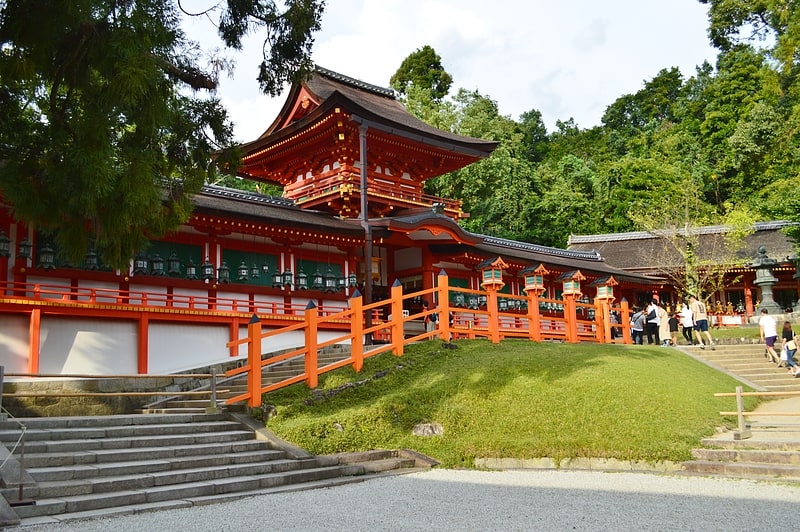
Also known as: 春日大社
Shrine in Nara, Japan. Kasuga Grand Shrine is a Shinto shrine in Nara, Nara Prefecture, Japan. It is the shrine of the Fujiwara family, established in 768 CE and rebuilt several times over the centuries. The interior is famous for its many bronze lanterns, as well as the many stone lanterns that lead up the shrine.
The architectural style Kasuga-zukuri takes its name from Kasuga Shrine's honden (sanctuary). The Torii at Kasuga-taisha is one of the oldest in Shintoism and helped influence the style of Torii seen across much of Japan. Kasuga Shrine, and the Kasugayama Primeval Forest near it, are registered as a UNESCO World Heritage Site as part of the "Historic Monuments of Ancient Nara".
The path to Kasuga Shrine passes through a deer park. In the park, deer are able to roam freely and are believed to be sacred messengers of the Shinto gods that inhabit the shrine and surrounding mountainous terrain. Kasuga Shrine and the deer have been featured in several paintings and works of art of the Nambokucho Period. Over three thousand stone lanterns line the way. The Man'yo Botanical Garden is adjacent to the shrine.[2]
Address: 160 Kasuganochō, Nara, 630-8212 Nara
Heijō Palace
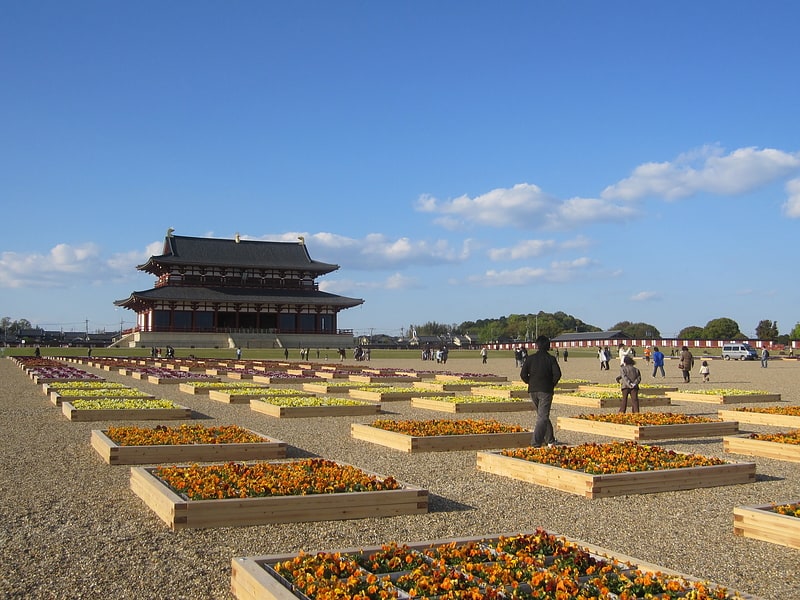
Also known as: 平城宮
Historic site of an imperial residence. Heijō Palace was the imperial residence in the Japanese capital city Heijō-kyō, during most of the Nara period. The palace, which served as the imperial residence and the administrative centre of for most of the Nara period from 710 to 794 AD, was located at the north-central location of the city in accordance with the Chinese models used for the design of the capital.
The palace consisted of a daidairi (大内裏, also pronounced taidairi), a large rectangular walled enclosure which contained several ceremonial and administrative buildings including the government ministries. Inside this enclosure was the separately walled residential compound of the emperor or the Inner Palace. In addition to the emperor's living quarters, the Inner Palace contained the residences of the imperial consorts, as well as certain official and ceremonial buildings more closely linked to the person of the emperor.
The original role of the palace was to manifest the centralised government model adopted by Japan from China in the 7th century—the Daijō-kan and its subsidiary Eight Ministries. The palace was designed to provide an appropriate setting for the emperor's residence, the conduct of great affairs of state, and the accompanying ceremonies.
After the capital was moved to Heian, the palace structures were either moved there or suffered several fires and other disasters and disappeared. The site was built over for agriculture that almost no trace of it remained, however, the location was still known. Excavations started in the 1970s and large-scale reconstruction based on contemporary literary sources and excavations starting in the 2000s.
The excavated remains of the palace, and the surrounding area, was established as a UNESCO World Heritage Site in 1998 along with a number of other buildings and area, as the "Historic Monuments of Ancient Nara."[3]
Address: Sakicho, Nara, 630-8577 Nara
Yakushi-ji

Also known as: 薬師寺
Landmark 7th-century Buddhist temple. Yakushi-ji is one of the most famous imperial and ancient Buddhist temples in Japan, that was once one of the Seven Great Temples of Nanto, located in Nara. The temple is the headquarters of the Hossō school of Japanese Buddhism. Yakushi-ji is one of the sites that are collectively inscribed as a UNESCO World Heritage Site, under the name of "Historic Monuments of Ancient Nara."
The main object of veneration, Yakushi Nyorai, also named "The Medicine Buddha", was one of the first Buddhist Deities to arrive in Japan from China in 680, and gives the temple its name.[4]
Address: 457 Nishinokyōchō, Nara, 630-8563 Nara
Nara Park

Also known as: 奈良公園
Public park with temples, museum and deer. Nara Park is a public park located in the city of Nara, Japan, at the foot of Mount Wakakusa. Established in 1880 it is one of the oldest parks in Japan. Administratively, the park is under the control of Nara Prefecture. The park is one of the "Places of Scenic Beauty" designated by the Ministry of Education, Culture, Sports, Science and Technology. Over 1,200 wild sika deer freely roaming around in the park are also under designation of MEXT, classified as natural treasure. While the official size of the park is about 502 hectares, the area including the grounds of Tōdai-ji, Kōfuku-ji, and Kasuga Shrine, which are either on the edge or surrounded by Nara Park, is as large as 660 hectares.
While Nara Park is usually associated with the broad areas of the temples and the park proper, previously private gardens are now open to public. These gardens make use of the temple buildings as adjunct features of their landscapes.
The park is home to the Nara National Museum and Todai-ji, where the largest wooden building in the world houses a 15-metre (50 ft) tall statue of Buddha.[5]
Address: Zoshicho, Nara, 630-8211 Nara
Kōfuku-ji
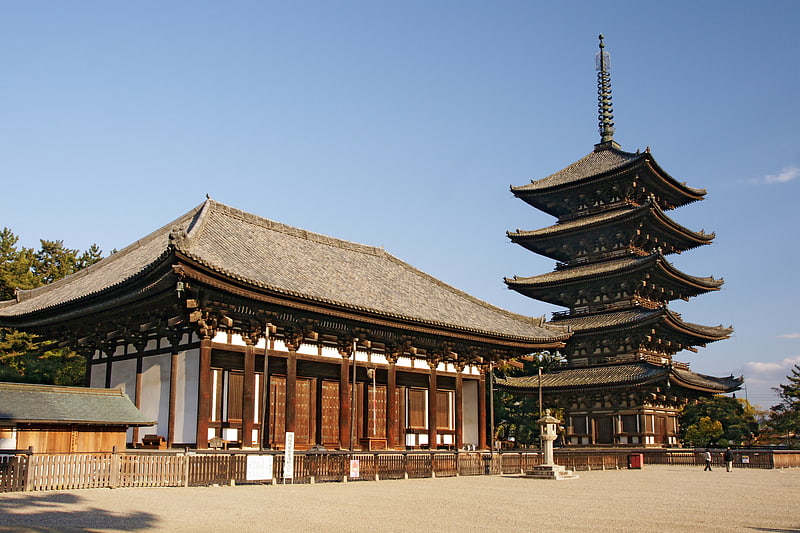
Also known as: 興福寺
Buddhist temples opened in 710 A.D.. Kōfuku-ji is a Buddhist temple that was once one of the powerful Seven Great Temples in the city of Nara, Japan. The temple is the national headquarters of the Hossō school.[6]
Address: 48 Noboriojicho, 630-8213 Nara
Tōshōdai-ji
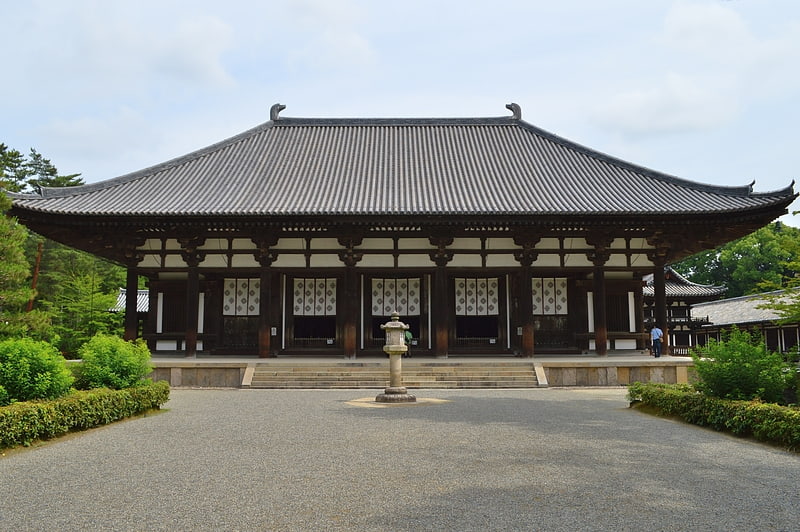
Also known as: 唐招提寺
Buddhist temple dating from 8th century. Tōshōdai-ji is a Buddhist temple of the Risshū sect in the city of Nara, in Nara Prefecture, Japan. The Classic Golden Hall, also known as the kondō, has a single story, hipped tiled roof with a seven bay wide facade. It is considered the archetype of "classical style".
It was founded in 759 by the Tang dynasty Chinese monk Jianzhen during the Nara period. Jianzhen was hired by the newly empowered clans to travel in search of funding from private aristocrats as well.
Tōshōdai-ji is one of the places in Nara that UNESCO has designated as World Heritage Site "Historic Monuments of Ancient Nara".
A reflection written by Yan Wenjing on the hope for friendly Sino-Japanese relations describing the author's discovery of lotus flowers imported from China which had been planted around the portrait of Jianzhen in the Tōshōdai-ji is included as one of the oral assessment passages on the Putonghua Proficiency Test.[7]
Nigatsu-dō

Also known as: 東大寺二月堂
Panoramic hall at Tōdai-ji temple. Nigatsu-dō is one of the important structures of Tōdai-ji, a temple in Nara, Japan. Nigatsu-dō is located to the east of the Great Buddha Hall, on the hillside of Mount Wakakusa. It includes several other buildings in addition to the specific hall named Nigatsu-dō, thus comprising its own sub-complex within Tōdai-ji.[8]
Address: 406-1 Zoshicho, 630-8587 Nara
Kōriyama Castle
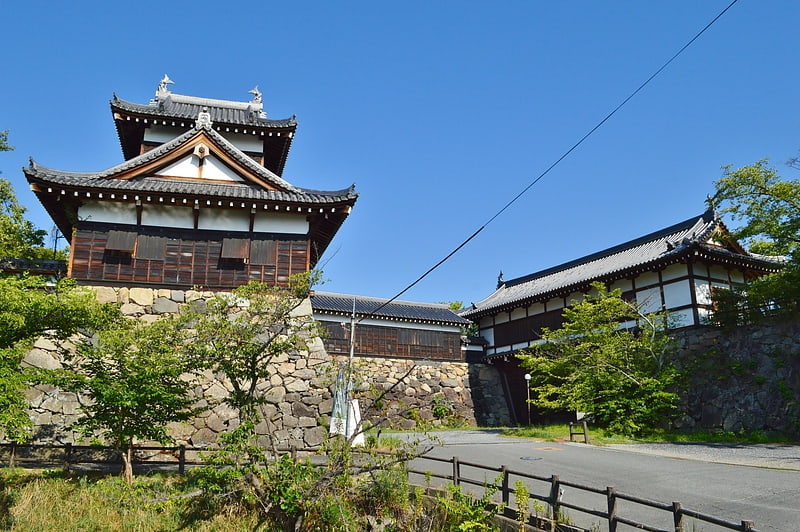
Also known as: 郡山城
Castle in Yamatokoriyama, Japan. Kōriyama Castle was a Japanese castle in what is now the city of Yamatokōriyama, Nara Prefecture, Japan. The Sengoku daimyō Tsutsui Junkei started construction of the castle, and Toyotomi Hidenaga made it his residence. In the Edo period, it became the headquarters of the Kōriyama Domain. During this time it was held by members of the Mizuno, Okudaira Matsudaira, Honda, Fujii Matsudaira, and Yanagisawa clans.
Today, many walls and moats are preserved in a public park in the city. The Yanagisawa Shrine stands on the grounds. The Castle was listed as one of the Continued Top 100 Japanese Castles in 2017.[9]
Hannya-ji
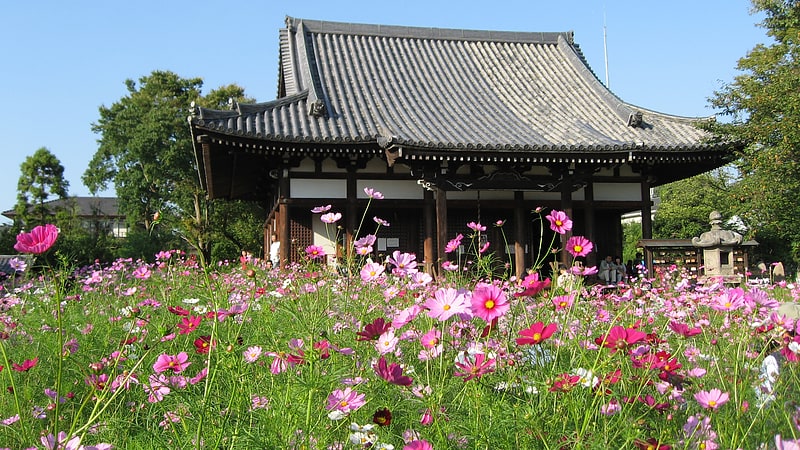
Temple in Nara, Japan. Hannya-ji is a Buddhist temple of the Shingon Ritsu sect in Nara, Japan. Its foundation is variously dated, but mention in a document in the Shōsōin provides a terminus ante quem of the mid-eighth century.[10]
Address: 221 Hannyajicho, 630-8102 Nara
Shōsōin
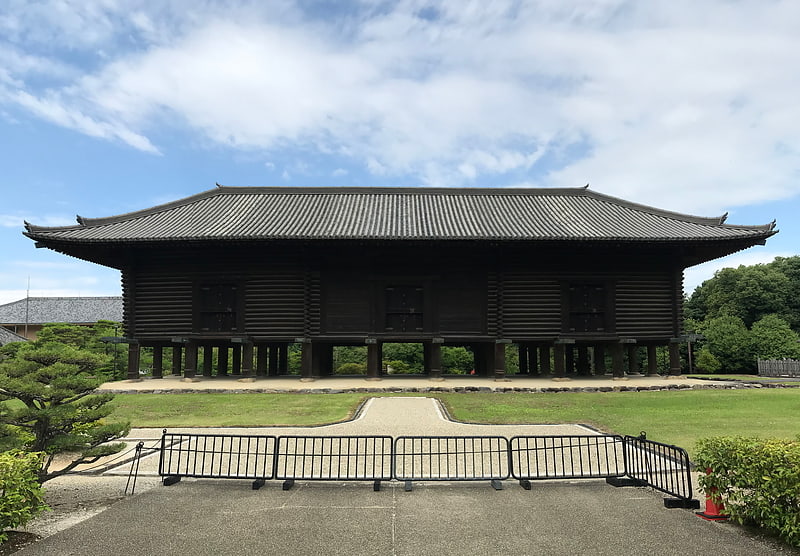
Also known as: 正倉院
Historic treasure house from 8th century. The Shōsō-in is the treasure house of Tōdai-ji Temple in Nara, Japan. The building is in the azekura style with a raised floor. It lies to the northwest of the Great Buddha Hall. The Shōsō-in houses artifacts connected to Emperor Shōmu and Empress Kōmyō, as well as arts and crafts of the Tempyō era of Japanese history.[11]
Address: 129 Zoshicho, 630-8211 Nara
Nara National Museum

Also known as: 奈良国立博物館
Museum in Nara, Japan. The Nara National Museum is one of the pre-eminent national art museums in Japan.[12]
Address: 50 Noboriojicho, 630-8213 Nara
Hokke-ji

Also known as: 法華寺
Ancient temple with gardens and a statue. Hokke-ji, is a Buddhist temple in the city of Nara, Japan.
Hokke-ji was built by Empress Kōmyō in 745, originally as a nunnery temple on the grounds where her father Fujiwara no Fuhito's mansion stood. According to records kept by the temple, the initial construction went on until around 782. It once had a large complex with several halls, gates, and two pagodas.
Hokke-ji was heavily damaged in the fierce Siege of Nara in 1180. The complex was restored in the 12th and 13th centuries, but was again affected by civil conflicts during the Sengoku period.
The current main hall, bell tower and the south gate are reconstructions of the 16th century, sponsored by Toyotomi Hideyori and his mother, Lady Yodo.
The temple's main worship statue is the wooden 11-faced Kannon, a National Treasure. The temple houses an ancient bath building, originally built by Empress Kōmyō, which she opened to the public.[13]
Address: 882 Hokkejicho, 630-8001 Nara
Gangō-ji
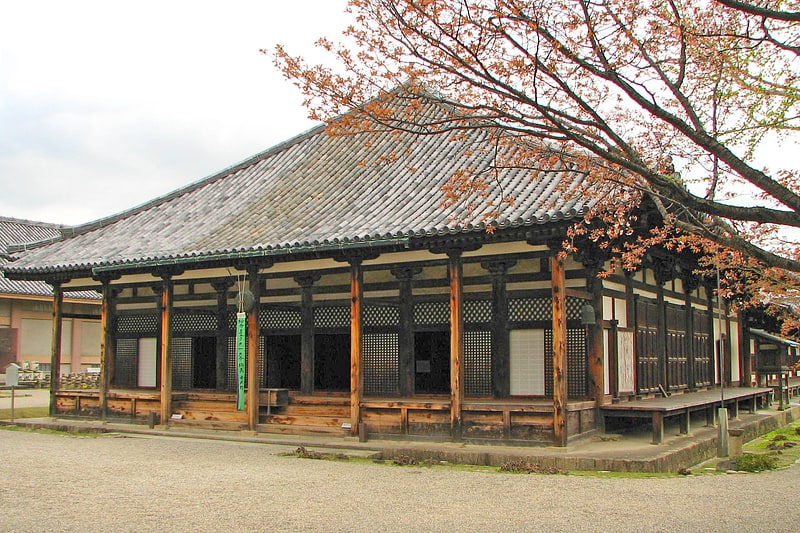
Also known as: 元興寺
Ancient Buddhist temple in lush setting. Gangō-ji is an ancient Buddhist temple, that was once one of the powerful Seven Great Temples, in Nara, Japan.[14]
Address: 11 Chuincho, 630-8392 Nara
Nara Kasugano International Forum Iraka
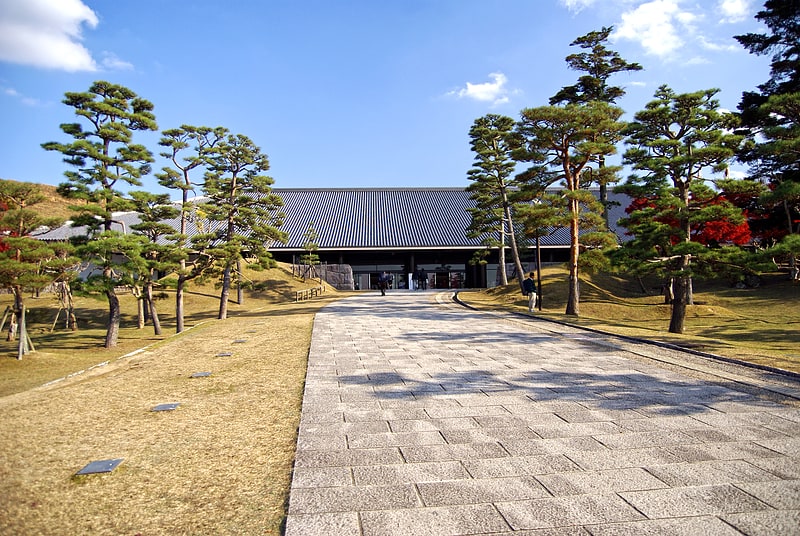
Also known as: 奈良春日野国際フォーラム 甍〜I・RA・KA〜
Convention center in Nara, Japan. Nara Kasugano International Forum IRAKA, formerly known as Nara Prefectural New Public Hall, is a convention center in Nara, Nara, Japan. Located near Kasuga Grand Shrine in Nara Park, the venue re-opened on July 1, 2015, annexing its adjacent public building that served as Nara Park Silk Road Exchange Hall that closed on December 31, 2014.[15]
Address: 101 Kasuganocho, 630-8212 Nara
Jōruri-ji
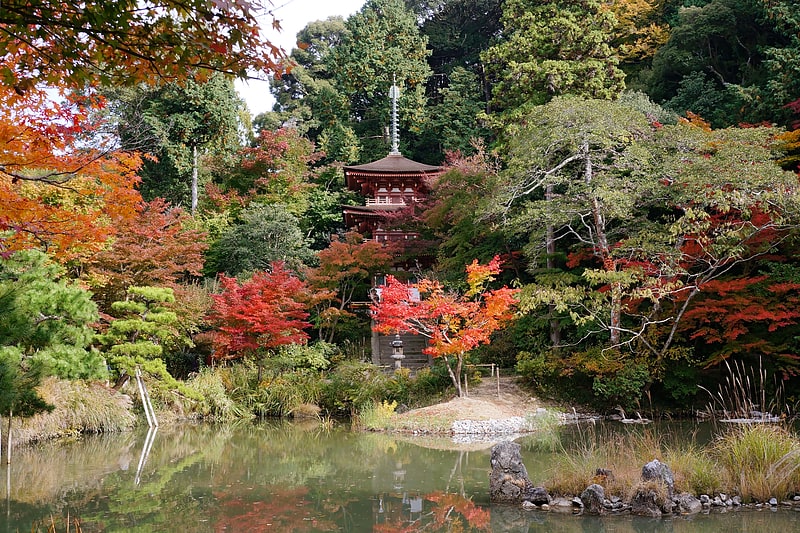
Also known as: 浄瑠璃寺
Temple in Kizugawa, Japan. Jōruri-ji is a temple of the Shingon Ritsu school with an historic Japanese garden located in Kizugawa, Kyoto Prefecture, Japan. It is one of the few remaining examples of a Paradise Garden of the early Heian period. The three-storied pagoda, the main hall, the group of nine sitting Amida Nyorai statues and the group of Four Heavenly Kings are all designated as National Treasures. The temple is heavily influenced by Pure Land thought.[16]
Address: 40 Ofudaba Kamochonishi, 619-1135 Kizugawa
Himegamisha Shrine
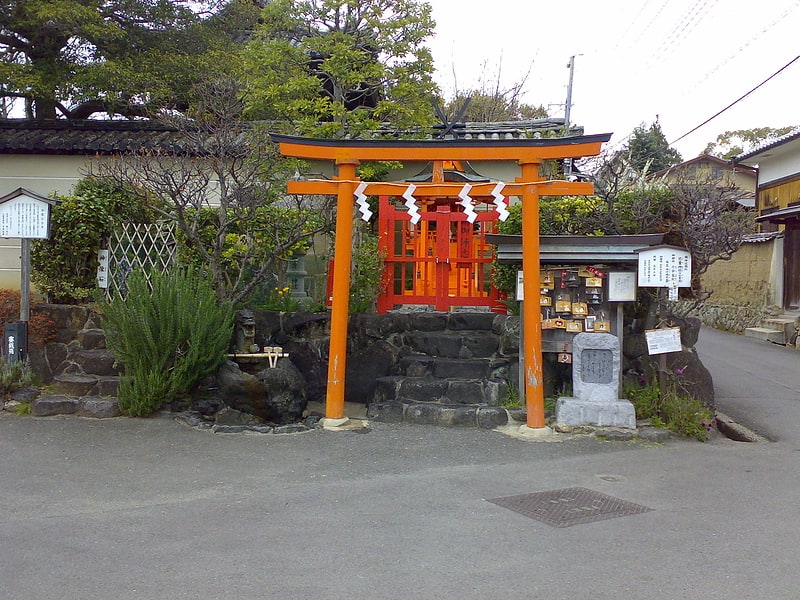
Also known as: 比賣神社
Shinto shrine in Nara, Japan. The Himegamisha Shrine is a Shinto shrine in the city of Nara, in Nara Prefecture, Japan. It is built in 1981 by the people of this neighborhood on the tomb called Hime-zuka that is estimated to be a burial place of Princess Tōchi, an Empress-consort of Emperor Kōbun. It is a sessha of the Kagami Shrine.[17]
Daian-ji
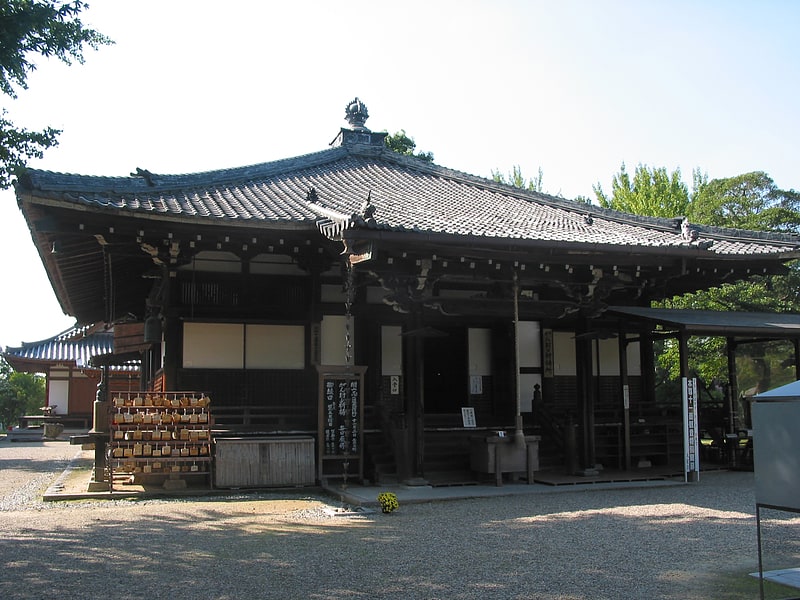
Also known as: 大安寺
Serene temple with 2 annual festivals. Daian-ji was founded during the Asuka period and is one of the Seven Great Temples of Nara, Japan.[18]
Address: 2-18-1 Daianji, 630-8133 Nara
Saidai-ji
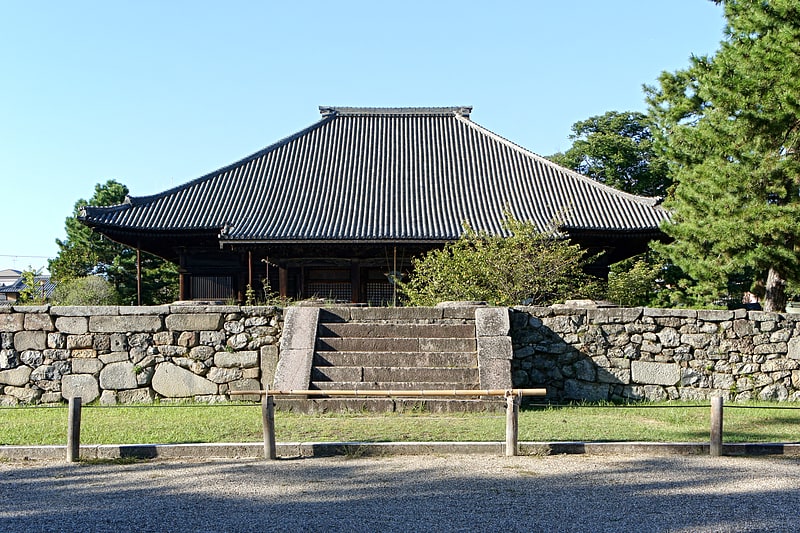
Also known as: 西大寺
Temple established in the 8th century. Saidai-ji or the "Great Western Temple" is a Buddhist temple that was once one of the powerful Seven Great Temples in the city of Nara, Nara Prefecture, Japan. The temple was first established in AD 765 as a counterpart to Tōdai-ji and it is the main temple of the Shingon Risshu sect of Buddhism after the sect's founder, Eison, took over administration in 1238. It has undergone several reconstruction efforts since then during the succeeding centuries.
One building, the Aizen-dō, houses a statue of Aizen Myō-ō, while the main image is of Shakyamuni Buddha, erected by Eison in 1249.[19]
Address: 1-1-5 Saidaijishibamachi, 631-0825 Nara
Akishino-dera

Also known as: 秋篠寺
Temple in Nara, Japan. Akishino-dera is a Buddhist temple in Nara, Japan. Founded in the eighth century, its Kamakura-period Hondō is a National Treasure.[20]
Address: 757 Akishinocho, 631-0811 Nara
Nara Prefectural Museum of Folklore
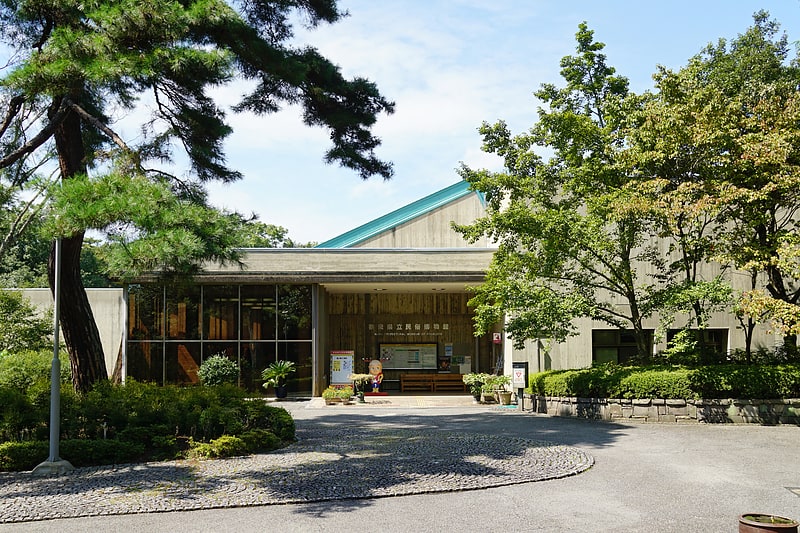
Also known as: 奈良県立民俗博物館
Museum in Yamatokoriyama, Japan. Nara Prefectural Museum of Folklore opened in Yamatokōriyama, Nara Prefecture, Japan, in 1974. Located at the foot of the Yata Hills within the 26.6 hectare Yamato Folk Park, the Museum collects, preserves, and displays artefacts relating to everyday life in Nara Prefecture from the Edo period to the Shōwa 40s. Among the forty-two thousand objects in the collection are 1,908 relating to forestry in the Yoshino District that have been jointly designated an Important Cultural Property. In the adjacent park are fifteen Edo-period minka, relocated from elsewhere in the prefecture, including the Former Usui Family Residence.[21]
Address: Nara, 545 Yata-chō
Nara Prefectural Museum of Art
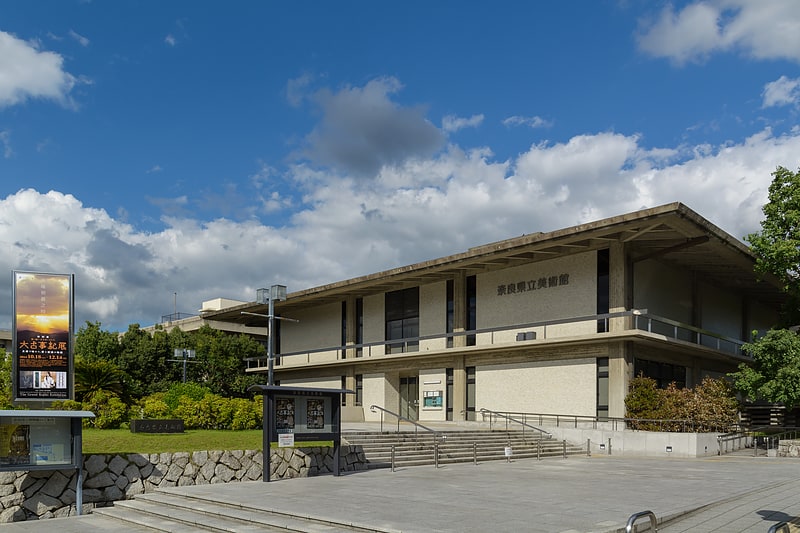
Also known as: 奈良県立美術館
Museum in Nara, Japan. Nara Prefectural Museum of Art opened in Nara, Japan in 1973. The collection numbers some 4,100 items and special exhibitions are also held.[22]
Address: Nara, 10-6 Noboriōji-chō
Tamukeyama Hachiman Shrine
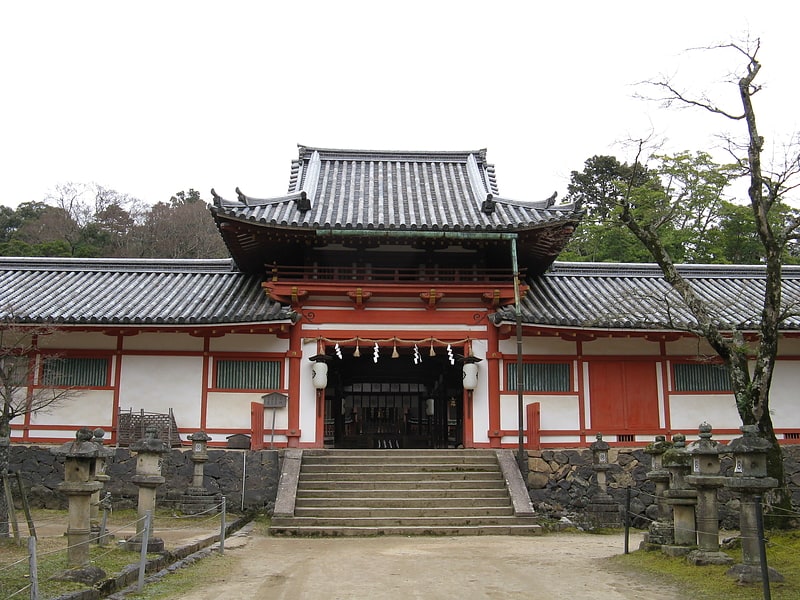
Also known as: 手向山八幡宮
Shinto shrine in Nara, Japan. Tamukeyama Hachiman Shrine is a Shinto shrine near Tōdai-ji, Nara, Nara Prefecture, Japan. It is a Hachiman shrine, dedicated to the kami Hachiman. It was established in 749. Kami enshrined here include Emperor Ojin, Emperor Nintoku, Empress Jingū and Emperor Chūai in addition to Hachiman.[23]
Address: 434 Zoshicho, 630-8211 Nara
Himuro Shrine

Also known as: 氷室神社
Shinto shrine in Nara, Japan. Himuro Shrine is a Shinto shrine in Nara, Nara Prefecture, Japan. It was established in 710. Kami enshrined here include Emperor Nintoku and Nukata no Onakatsuhiko no Mikoto. The shrine's main festival is held annually on October 1.[24]
Address: 1-4 Kasugano-cho, 630-8212 Nara
Kikō-ji
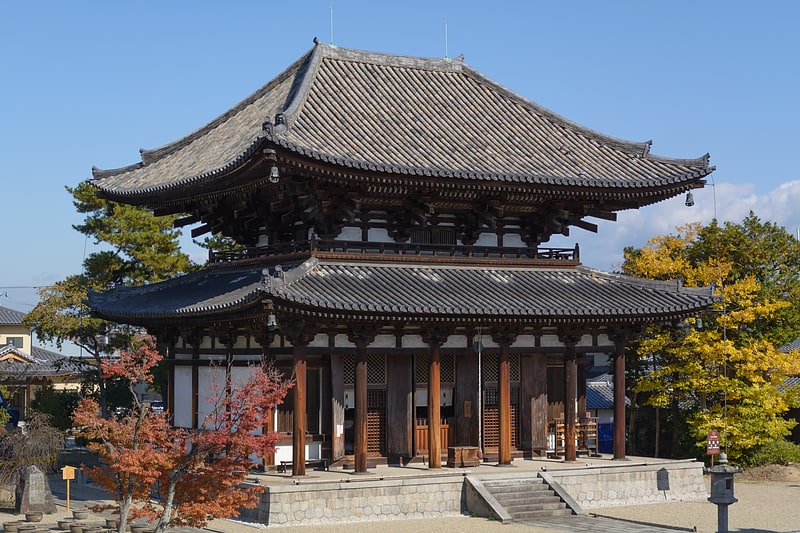
Also known as: 喜光寺
Temple in Nara, Japan. Kikō-ji is a Buddhist temple in Nara, Japan. Founded in the eighth century, its Muromachi-period Hondō and the Heian-period statue of Amida Nyorai enshrined within are Important Cultural Properties.[25]
Address: 508 Sugaharacho, 631-0842 Nara
Futai-ji
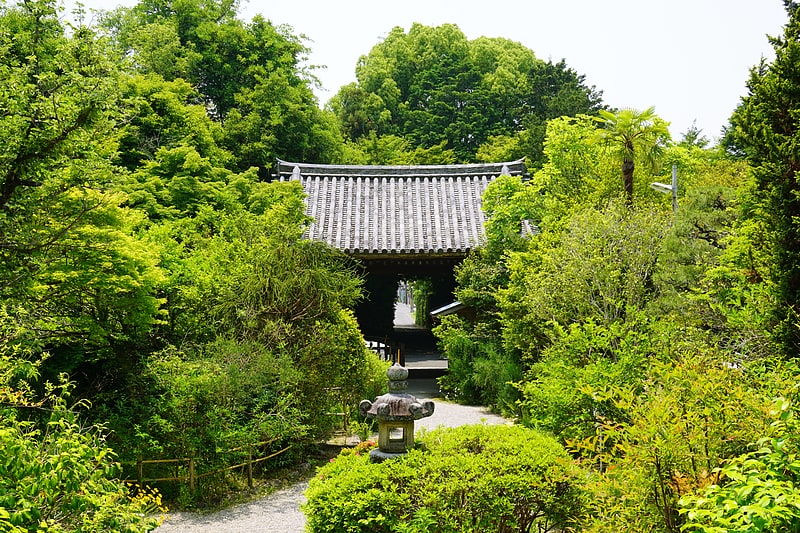
Also known as: 不退寺
Temple in Nara, Japan. Futai-ji, also known as Narihira-dera, is a Buddhist temple in Nara, Japan.
The temple was opened by Ariwara no Narihira in 847, known as the author of the Tales of Ise. The temple was built over a place where it was formerly a mansion of Narihira's grandfather, former Emperor Heizei. The main hall houses a Shō-kannon (聖観音) (a form of Avalokiteśvara or Guan Yin) buddha image as its primary worship object, surrounded by five Myo-O, as well as a small Shinto shrine also inside the same building.[26]
Enjō-ji
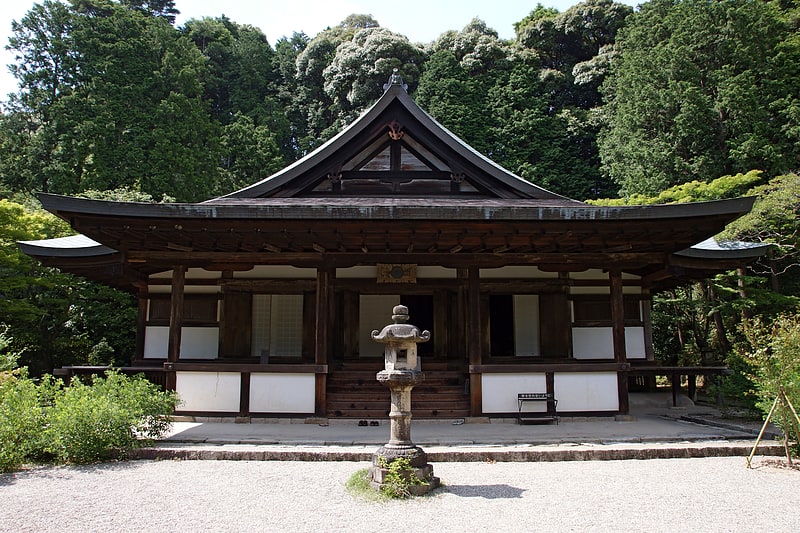
Also known as: 円成寺
Temple in Nara, Japan. Enjō-ji is a Shingon temple in the northeast of Nara, Japan. A number of its buildings and images have been designated National Treasures and Important Cultural Properties, and its late-Heian period gardens are a Place of Scenic Beauty.[27]
Byakugō-ji
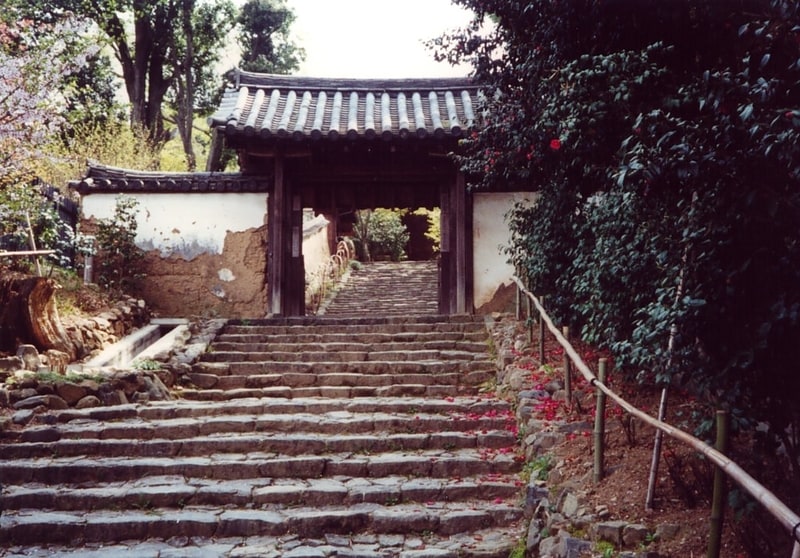
Also known as: 白毫寺
Temple in Nara, Japan. Byakugō-ji is a Buddhist temple in Nara, Japan. A number of wooden statues of the Heian and Kamakura periods have been designated Important Cultural Properties and the temple's five-coloured camellias are a Prefectural Natural Monument.[28]
Mount Wakakusa

Also known as: 若草山
Hill in Japan. Mount Wakakusa, also known as Mount Mikasa, is a 342-metre-high hill located in Nara, Nara Prefecture, Japan, to the east of Nara Park. The mountain's name literally translates to "young grass".
On the fourth Saturday of each January, the dead grass of Mount Wakakusa is burned in an annual festival known as Yamayaki (山焼き literally "mountain burning"). The tradition supposedly originated from a boundary dispute between two temples, Tōdai-ji and Kōfuku-ji in 1760. As the mediations failed, the entire mountain was set ablaze. Other explanations suggest the extermination of wild boars or pests as a result. The festival today begins with a ceremonial igniting by members of both temples, followed by a fireworks display. The festival has been postponed due to poor weather in the past.[29]
Isui-en

Also known as: 依水園
Art museum in Nara, Japan. Isui-en is a Japanese garden located in Nara, the old capital of Japan near Kyōto. It has been preserved since its creation in the Meiji era, and is the only walking garden in Nara. It is divided into two sections, which were originally two separate gardens, and each features a pagoda.[30]
Address: 74 Suimoncho, 630-8208 Nara
Irie Taikichi Memorial Museum of Photography Nara City
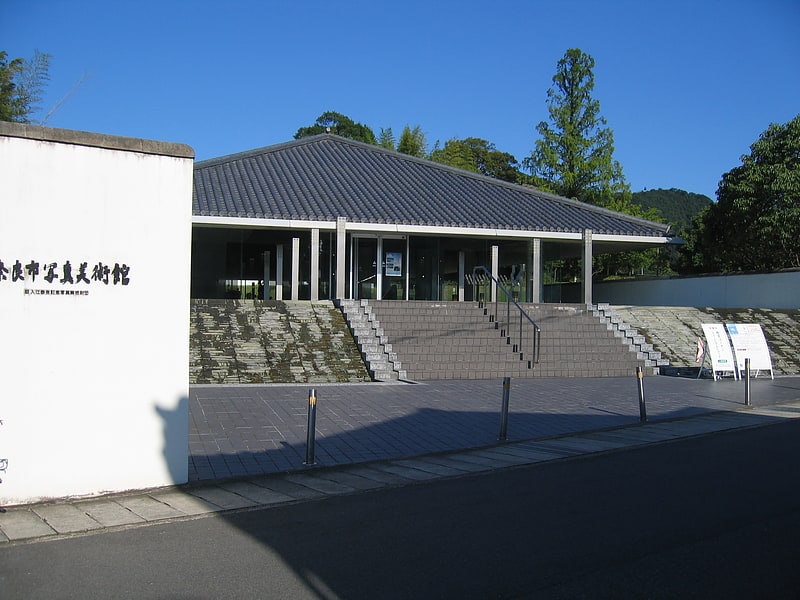
Also known as: 入江泰吉記念奈良市写真美術館
Museum in Nara, Japan. Irie Taikichi Memorial Museum of Photography Nara City opened in Nara, Japan, in 1992. Located near Shin-Yakushi-ji and designed by Kishō Kurokawa, the Museum was formerly known as the Nara City Museum of Photography. The collection includes the complete oeuvre of Irie Taikichi, some 80,000 works; a set of 1,025 Meiji and Taishō glass plates by Kudō Risaburō that are a Registered Tangible Cultural Property; and photographs by Tsuda Yōho.[31]
Address: Nara, 600-1 Takabatake-chō
Neiraku Museum
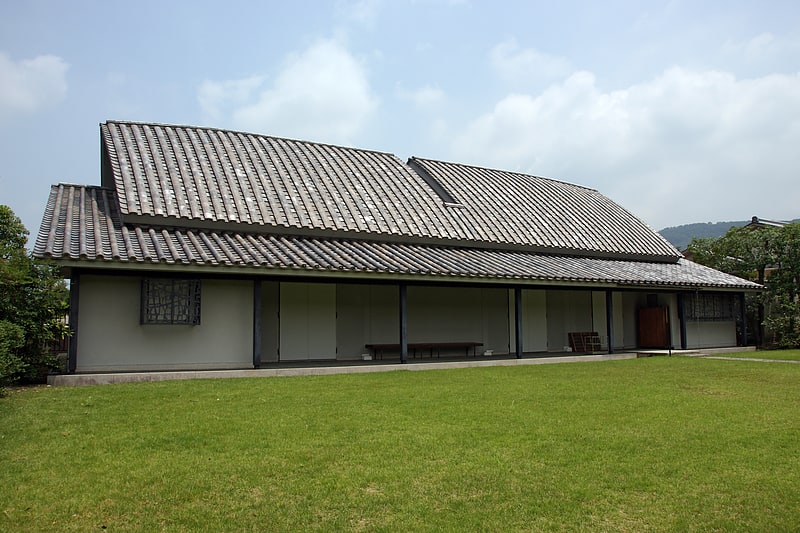
Also known as: 寧楽美術館
Museum in Nara, Japan. Neiraku Museum is an art museum in the city of Nara, central Japan.
The museum opened in April 1969. It contains the works collected by Nakamura Junsaku (1875-1953), who was the founder of the Isuien Garden. The collection totals over 2000 items, which includes bronze wares, seals and mirrors of ancient China as well as pottery of ancient Korea. The museum building was built in a traditional style and features rotating exhibitions.[32]
Address: Nara-shi, Suimonchō, 〒630-8208 Nara
Ryōsen-ji
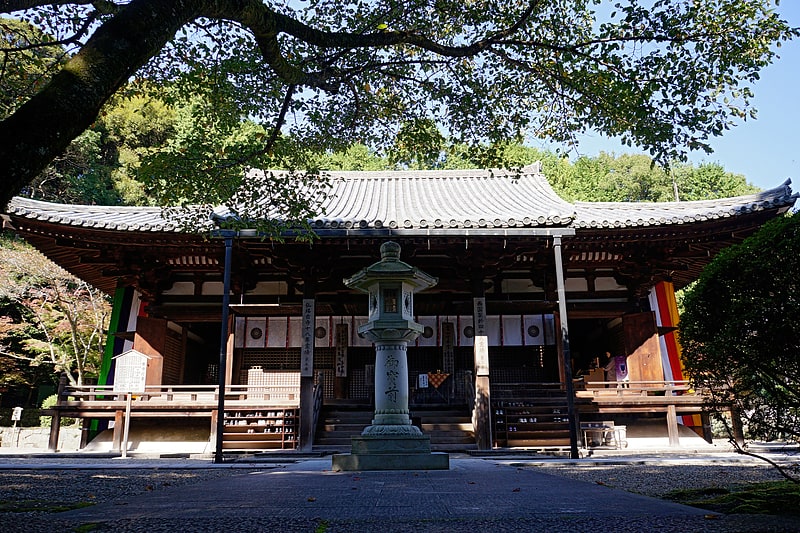
Also known as: 霊山寺
Temple in Nara, Japan. Ryōsen-ji is a Buddhist temple in Nara, Japan. Founded in the eighth century, the Hondō is a National Treasure and a number of other buildings and temple treasures have been designated Important Cultural Properties.[33]
Nara Centennial Hall
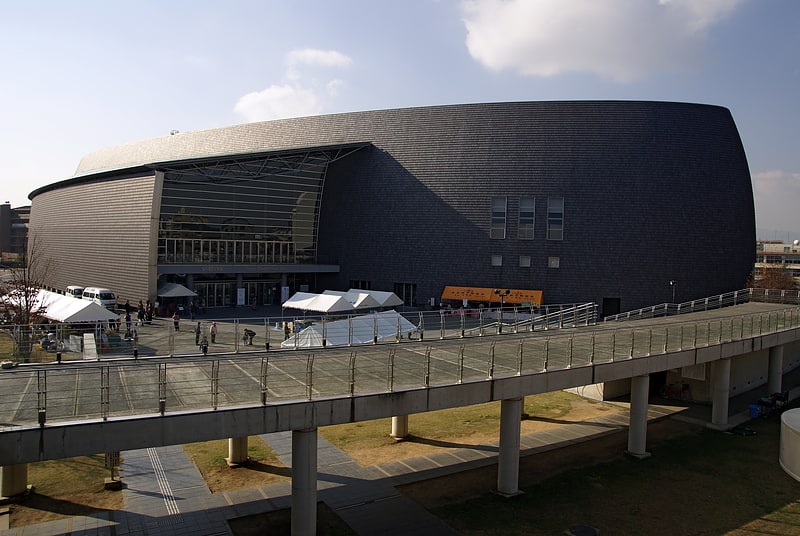
Also known as: なら100年会館
Concert hall in Nara, Japan. Nara Centennial Hall is a multi-use complex in Nara, Japan. It opened in 1999 as part of the centennial celebrations of the municipality of Nara. There is a large hall that seats up to 1720, a smaller concert hall with a capacity of 446, and a gallery. Arata Isozaki was the architect, with acoustical design by Nagata Acoustics.[34]
Address: Nara, 7-1 Sanjōmiyamae
Museum of Japanese Art
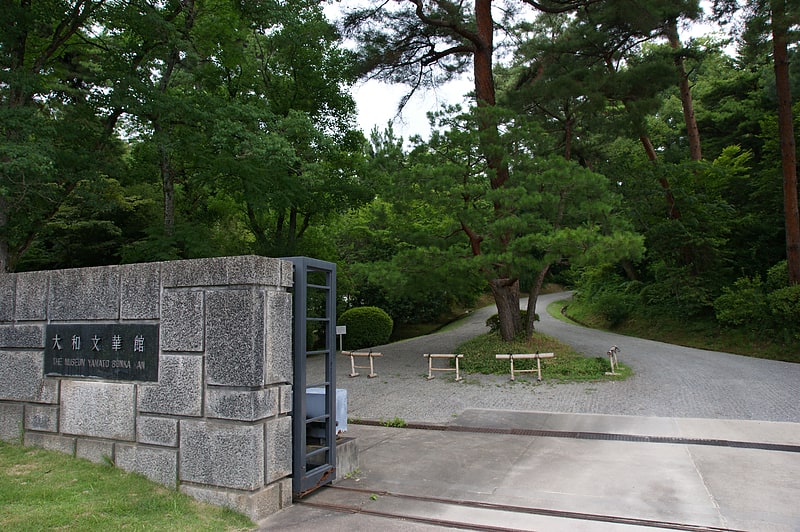
Also known as: 大和文華館
Museum in Nara, Japan. The Museum of Japanese Art Yamato Bunkakan is a museum of Asian art in Nara, Nara.
The museum was established in 1960 to preserve and display the private collection of Kintetsu Corporation (named Kinki Nippon Railway Co. Ltd. till June 27, 2003).[35]
Address: 1-11-6 Gakuenminami, 631-0034 Nara